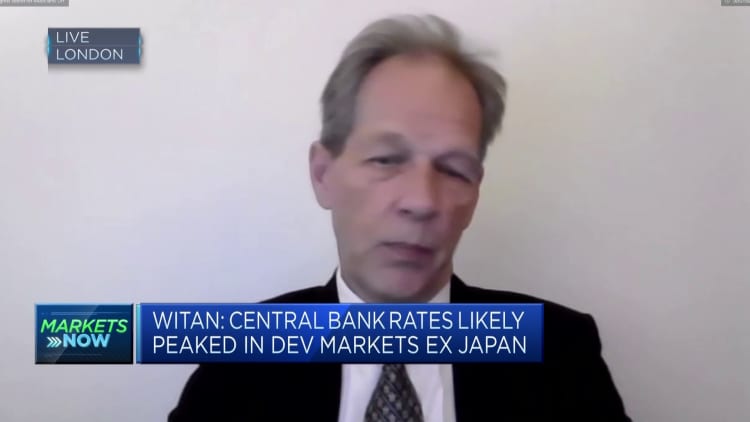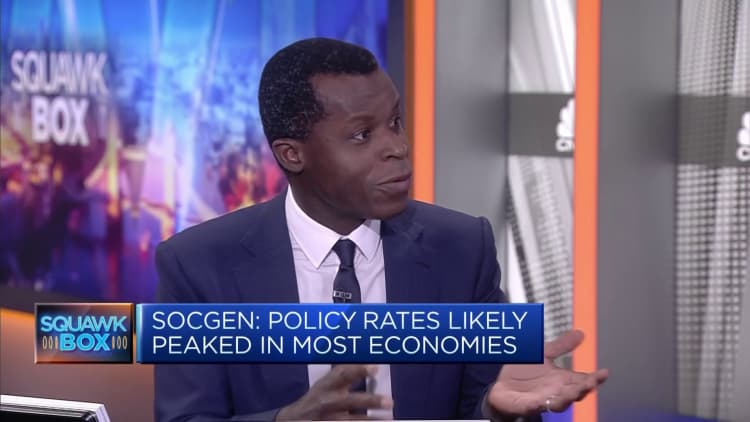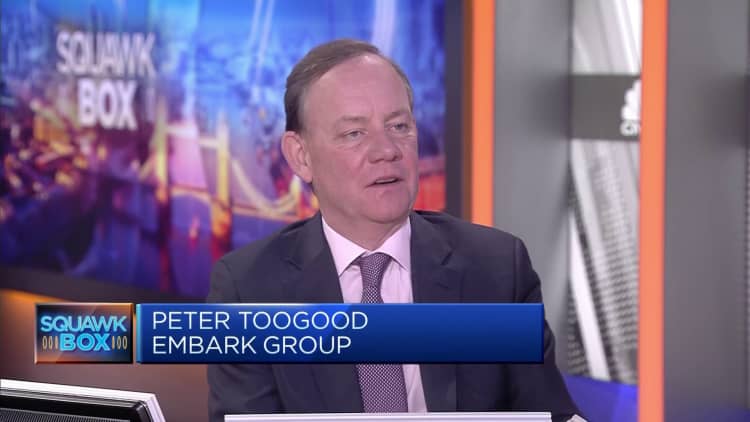A security guard at the New York Stock Exchange (NYSE) in New York, US, on Tuesday, March 28, 2023.
Victor J. Blue | Bloomberg | Getty Images
With central banks having hiked interest rates at breakneck speed and those rates likely to stay higher for longer while the lagged effects set in, the macroeconomic outlook for 2024 is far from clear.
The International Monetary Fund baseline forecast is for it to slow from 3.5% in 2022 to 3% in 2023 and 2.9% in 2024, well below the historical average of 3.8% between 2000 and 2019, led by a marked slowdown in advanced economies.
The Washington-based institution sees U.S. GDP growth, which has remained surprisingly resilient in the face of over 500 basis points of interest rate hikes since March 2022, to remain among the strongest developed market performers at 2.1% this year and 1.5% next year.
The U.S. economy’s resilience has fueled an emerging consensus that the Federal Reserve will achieve its desired “soft landing,” slowing inflation without tipping the economy into recession.
The market is now largely pricing a peak at the current Fed funds target range of 5.25-5.5%, with interest rate cuts to come next year.
Yet Deutsche Bank‘s economists, in a 2024 outlook report published Monday, were quick to point out that monetary policy operates with lags that are “highly uncertain in their timing and impact.”
“With the lagged impact of rate hikes taking effect, we can already see clear signs of data softening. In the U.S., the most recent jobs report showed the highest unemployment rate since January 2022, credit card delinquencies are at 12-year highs, and high yield defaults are comfortably off the lows,” Deutsche’s Head of Global Economics and Thematic Research, Jim Reid, and Group Chief Economist David Folkerts-Landau said in the report.
“At the outer edges of the economy there is obvious stress that is likely to spread in 2024 with rates at these levels. In the Euro Area, Q3 saw a -0.1% decline in GDP, with the economy in a period of stagnation since Autumn 2022 that will likely extend to mid-Summer 2024.”
The German lender has a considerably bleaker prognosis than market consensus, projecting that Canada will have the highest GDP growth among the G7 in 2024 at just 0.8%.
“Although that is still positive and the profile improves through the year, it means the major economies will be more vulnerable to a shock as they work through the lag of this most aggressive hiking cycle for at least four decades,” Reid and Folkerts-Landau said, noting that potential “macro accidents” would be more likely in the aftermath of such rapid tightening.
“We had 10-15 years of zero/negative rates, plus an increase in global central bank balance sheets from around $5 to $30 trillion at the recent peak, and it was only a couple of years ago that most expected ultra-loose policy for much of this decade. So it’s easy to see how bad levered investments could have been made that would be vulnerable to this higher rate regime.”
U.S. regional banks triggered global market panic earlier this year when Silicon Valley Bank and several others collapsed, and Deutsche Bank suggested that some vulnerabilities remain in that sector, along with commercial real estate and private markets, creating “a bit of a race against time.”
‘Higher for longer’ and regional divergence
The prospect of “higher for longer” interest rates has dominated the market outlook in recent months, and Goldman Sachs Asset Management economists believe the Fed is unlikely to consider cutting rates next year unless growth slows by substantially more than current projections.
In the euro zone, weaker growth momentum and a large drag from tighter fiscal policy and lending conditions increase the likelihood that the European Central Bank pauses its monetary policy tightening and potentially pivots toward cuts in the second half of 2024.
“While the Fed and ECB seem to have steered away from a hard landing path during the tightening cycle, exogenous shocks or a premature pivot to policy easing may reignite inflation in a way that requires a recession to force it lower,” GSAM economists said.
“Conversely, further monetary tightening might trigger a downturn just as the effects of prior tightening begin to take hold.”

GSAM also noted regional divergence in the trajectory of growth prospects and inflation patterns, with Japan’s economy surprising positively on the back of resurgent domestic demand driving wage growth and inflation after many years of stagnation, while China’s property market indebtedness and demographic headwinds skew its risks to the downside.
Meanwhile Brazil, Chile, Hungary, Mexico, Peru and Poland were early hikers of interest rates in emerging markets and were among the first to see inflation slow sharply, meaning their central banks have either begun cutting rates or are close to doing so.
“In a desynchronized global cycle, with higher-for-longer rates and slower growth in most advanced economies, the road ahead remains uncertain,” GSAM said, adding that this calls for a “diversified and risk conscious investment approach across public and private markets.”
Recession risk ‘delayed rather than diminished’
In a roundtable event on Tuesday, JPMorgan Asset Management strategists echoed this note of caution, claiming that the risk of a U.S. recession was “delayed rather than diminished” as the impact of higher rates feeds through into the economy.
JPMAM Chief Market Strategist Karen Ward noted that many U.S. households took advantage of 30-year fixed rate mortgages while rates were still around 2.7%, while in the U.K., many shifted to five-year fixed rates during the Covid-19 pandemic, meaning the “passthrough of interest rates is much slower” than previous cycles.
However, she highlighted that U.K. exposure to higher rates is due to rise from about 38% at the end of 2023 to 60% at the end of 2024, while first-time buyers in the U.S. will be exposed to much higher rates and the cost of other consumer debt, such as auto loans, has also risen sharply.
“I think the the key conclusion here is that interest rates do still bite, it’s just taking longer this time around,” she said.

The U.S. consumer has also been spending pent-up savings at a faster rate than European counterparts, Ward highlighted, suggesting this is “one of the reasons why the U.S. has outperformed” so far, along with “incredibly supportive” fiscal policy in the form of major infrastructure programs and post-pandemic support programs.
“All of that fades into next year as well, so the backdrop for the consumer just doesn’t look as strong for us as we go into 2024 that will start to bite a little bit,” she said.
Meanwhile, corporates will over the next few years have to start refinancing at higher interest rates, particularly for high-yield companies.
“So growth slows in 2024, and we still think the risks of a recession are significant, and therefore we’re still pretty cautious about the idea that we’ve been through the worst and we’re looking at an upswing from here on,” Ward said.
Credit: Source link




